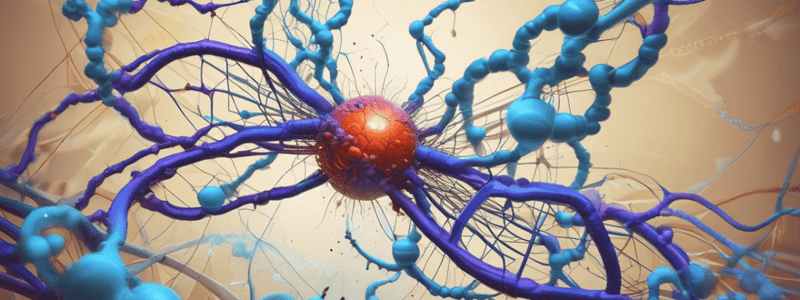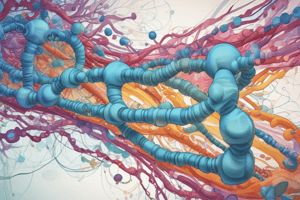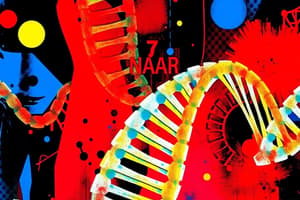Podcast
Questions and Answers
What is the primary function of stem-loops in mRNA secondary structure?
What is the primary function of stem-loops in mRNA secondary structure?
- To regulate transcriptional control
- To form a knot-like structure
- To create a stable, double-stranded region with a loop at the end (correct)
- To act as a binding site for RNA-binding proteins
What is the role of RNA-binding proteins in regulating gene expression?
What is the role of RNA-binding proteins in regulating gene expression?
- To act as a co-repressor of transcriptional control
- To alter riboswitch conformation, affecting gene expression (correct)
- To recognize and bind specific small molecules
- To inhibit translation initiation by binding to the ribosome binding site
What is the basis for classifying riboswitches into different categories?
What is the basis for classifying riboswitches into different categories?
- The type of small molecule that binds to the riboswitch
- The ligand specificity, secondary structure, and gene regulation of the riboswitch (correct)
- The type of RNA-binding protein that interacts with the riboswitch
- The origin of the riboswitch, whether it is bacterial or archaeal
What is the outcome of ligand binding to a riboswitch?
What is the outcome of ligand binding to a riboswitch?
What is the role of riboswitches in regulating translation initiation?
What is the role of riboswitches in regulating translation initiation?
What is the function of an ON switch riboswitch?
What is the function of an ON switch riboswitch?
What happens when Rho reaches the terminator in a normal situation?
What happens when Rho reaches the terminator in a normal situation?
What is the function of TRAP protein in the Trp operon?
What is the function of TRAP protein in the Trp operon?
What happens when there is a low concentration of Trp?
What happens when there is a low concentration of Trp?
What is the function of anti-TRAP protein?
What is the function of anti-TRAP protein?
What is the signal that triggers the formation of anti-TRAP protein?
What is the signal that triggers the formation of anti-TRAP protein?
What is the role of tRNA in the formation of anti-TRAP protein?
What is the role of tRNA in the formation of anti-TRAP protein?
What is the difference between the Trp operon in E. coli and B. subtilis?
What is the difference between the Trp operon in E. coli and B. subtilis?
What is a common characteristic of the three mechanisms of attenuation?
What is a common characteristic of the three mechanisms of attenuation?
What is the significance of the study on different bacteria?
What is the significance of the study on different bacteria?
What is the function of the ribosome in the mechanism of attenuation in E. coli?
What is the function of the ribosome in the mechanism of attenuation in E. coli?
Flashcards are hidden until you start studying
Study Notes
MRNA Secondary Structure
- Riboswitches are regions of mRNA that can adopt specific secondary structures
- These structures are critical for riboswitch function and can be altered by binding of small molecules
- Secondary structures can be:
- Stem-loops: stable, double-stranded regions with a loop at the end
- Pseudoknots: regions where the RNA strand folds back on itself, forming a knot-like structure
- Junctions: regions where multiple stem-loops meet
RNA-binding Proteins
- RNA-binding proteins can interact with riboswitches to regulate gene expression
- These proteins can:
- Bind specifically to riboswitch secondary structures
- Alter riboswitch conformation, affecting gene expression
- Act as co-factors to enhance or inhibit riboswitch function
Riboswitch Classification
- Riboswitches can be classified into several categories based on:
- Ligand specificity: e.g., purine, thiamine, or flavin mononucleotide (FMN) binding
- Secondary structure: e.g., stem-loop, pseudoknot, or junction
- Gene regulation: e.g., transcriptional or translational control
- Bacterial or archaeal origin: e.g., TPW, TPP, or FMN riboswitches
RNA-ligand Interactions
- Riboswitches recognize and bind specific small molecules (ligands) to regulate gene expression
- Ligand binding can:
- Induce conformational changes in the riboswitch, affecting gene expression
- Alter the accessibility of the ribosome binding site
- Inhibit or activate translation initiation
Translation Initiation
- Riboswitches can regulate translation initiation by controlling:
- Ribosome binding site (RBS) accessibility
- Initiation codon recognition
- Translation initiation complex formation
- Riboswitches can act as:
- ON switches: allowing translation initiation when bound to a ligand
- OFF switches: inhibiting translation initiation when bound to a ligand
Studying That Suits You
Use AI to generate personalized quizzes and flashcards to suit your learning preferences.



